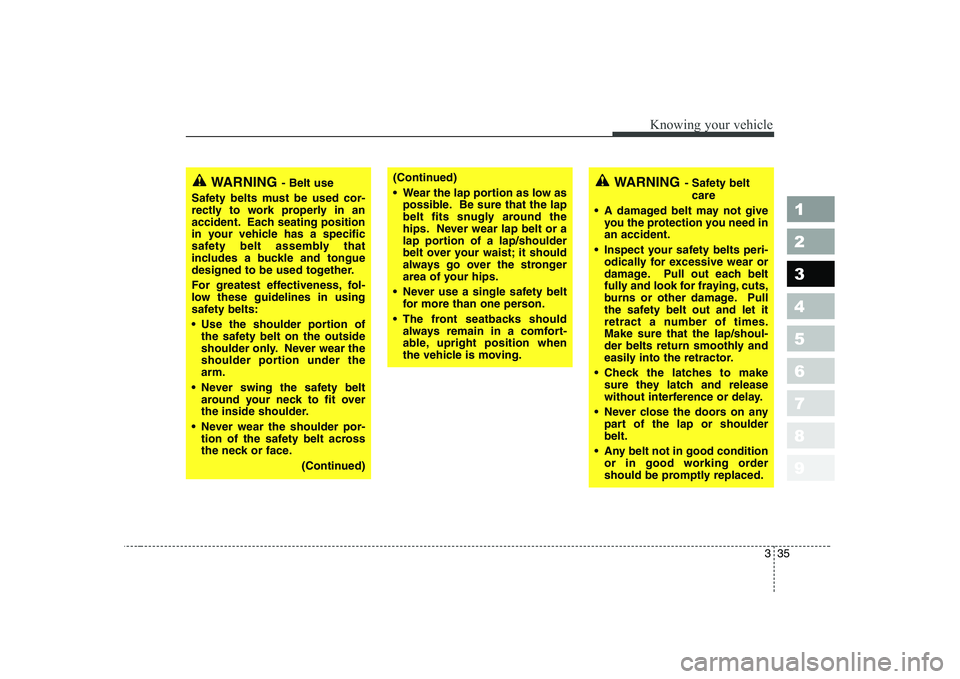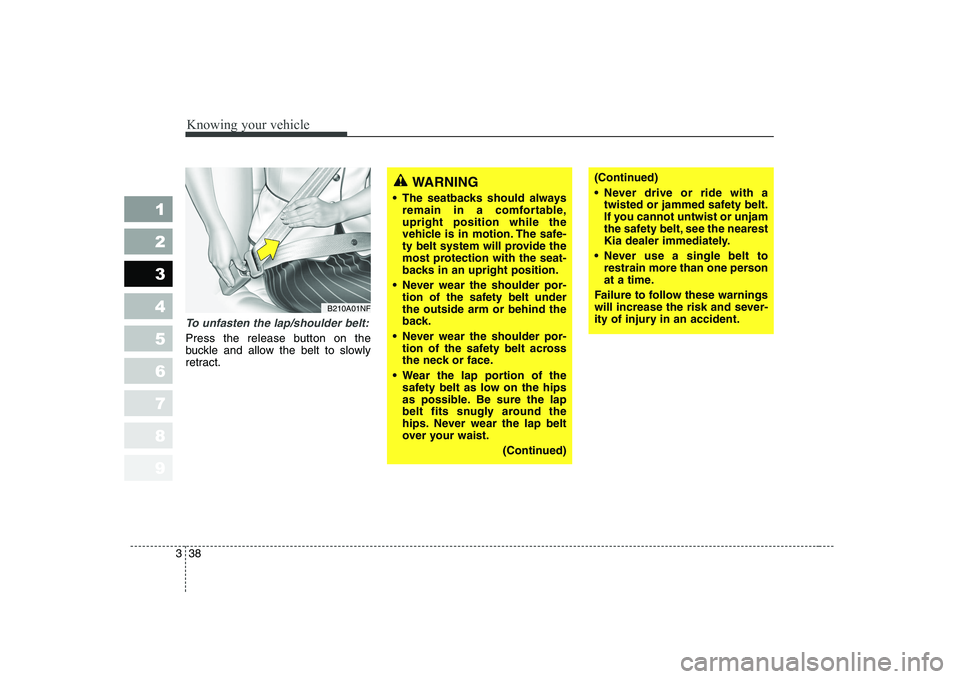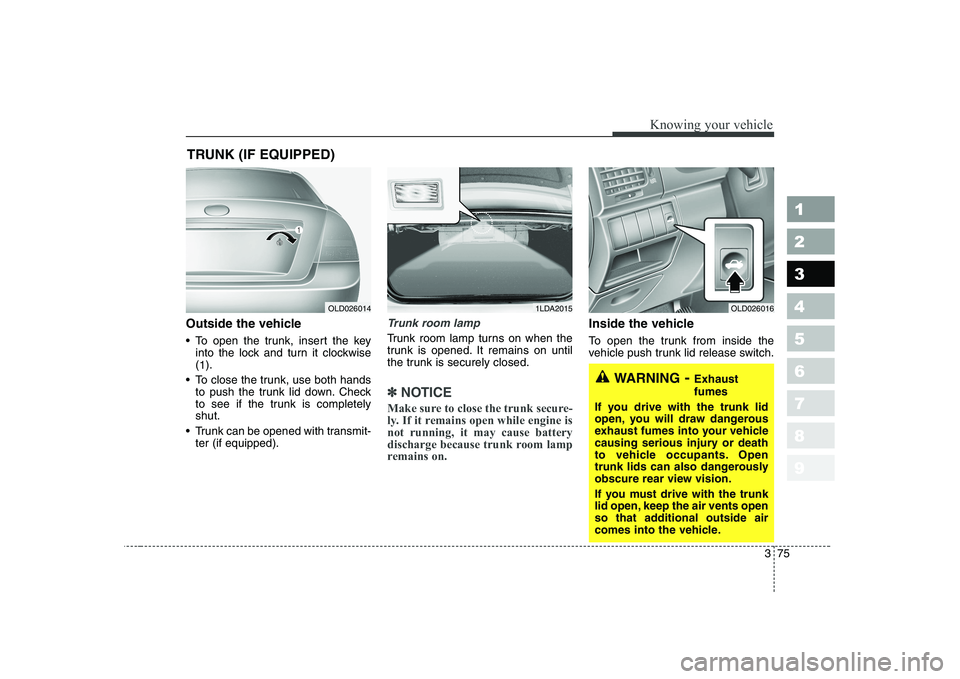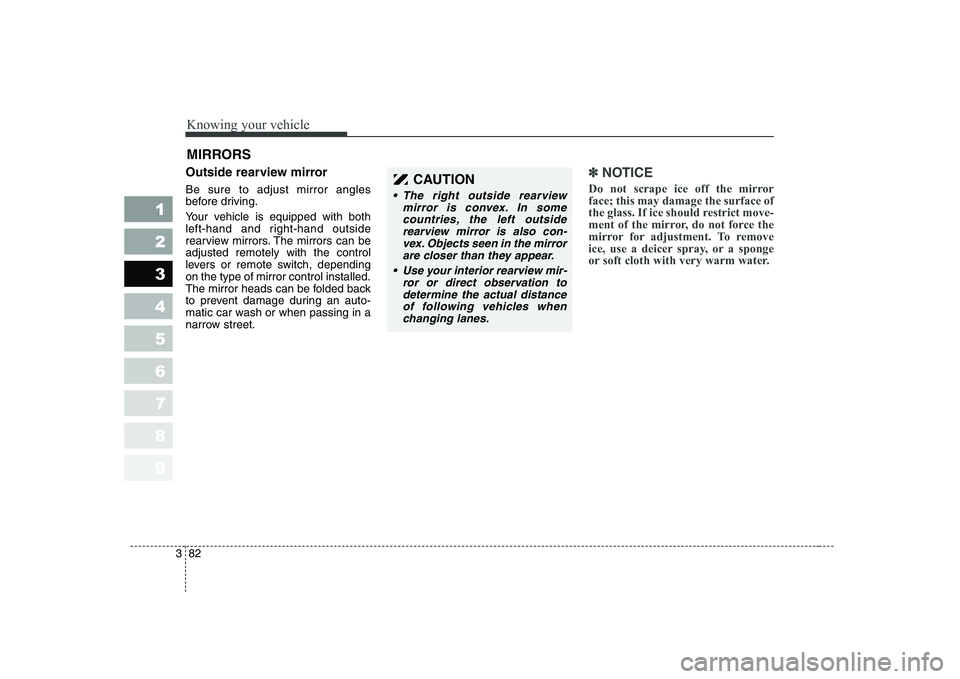Page 8 of 327
Your vehicle at a glance
2
2
1 23456789
INTERIOR OVERVIEW
1. Door lock/unlock button
2. Outside rearview mirror control switch*
3. Power window switches*
4. Master power door lock control*
5. Master power window control lock*
6. Vent controls
7. Instrument cluster
8. Steering wheel
9. Steering wheel tilt*
10. Trunk release button
11. Instrument panel illumination*
12. TCS button*
13. Headlights leveling device*
14. Rear fog light*
15. Hood release lever
16. Brake pedal
17. Accelerator pedal
18. Fuel filler lid release lever
* : if equipped
OLD006002/OLD026018
Page 17 of 327
37
1 23456789
Knowing your vehicle
Operating door locks from
outside the vehicle
Turn the key toward rear of vehicleto unlock and toward front of vehi-
cle to lock.
Doors can also be locked and unlocked with the transmitter key. Once the doors are unlocked, it
may be opened by pulling the door
handle.
When closing the door, push the door by the hand. Make sure that
doors are closed securely.
If you lock/unlock the front door with a key, all vehicle doors will
lock/unlock automatically. (ifequipped)
❈ If your vehicle is equipped with the
remote keyless entry system,
there is no key lock on the front
passenger's door. To lock a door without the key, push
the inside door lock button (1) or
door lock switch (2, if equipped) to
the “LOCK” position and close thedoor (3).
✽✽
NOTICE
Always remove the ignition key, engage the parking brake, close allwindows and lock all doors when
leaving your vehicle unattended.
DOOR LOCKS
OLD026004
LockUnlock
1LDA2005
Page 29 of 327
319
1 23456789
Knowing your vehicle
Adjusting the driver’s seatbackrecliner
To recline the seatback:
1. Lean forward slightly and lift up on the seatback recline lever located on the outside of the seat, at the
rear.
2. Carefully lean back on the seat and adjust the seatback of the
seat to the position you desire. 3. Release the lever and make sure
the seatback is locked in place.
(The lever MUST return to its orig-
inal position for the seatback to
lock.)
1LDA2029
WARNING
Driving or riding in a vehicle
with a front seatback reclinedcould lead to serious or fatal
injury in an accident. If a front
seat is reclined during an acci-
dent, the occupant’s hips may
slide under the lap portion of
the safety belt applying great
force to the unprotected
abdomen or neck. Serious orfatal internal injuries could
result. Keep the seatbacks in a
comfortably upright position
whenever the vehicle is inmotion.
Page 33 of 327
323
1 23456789
Knowing your vehicle
Adjusting the seatback recliner
To recline the seatback:
1. Lean forward slightly and lift up onthe seatback recline lever located on the outside of the seat, at the
rear.
2. Carefully lean back on the seat and adjust the seatback of the
seat to the position you desire. 3. Release the lever and make sure
the seatback is locked in place.
(The lever MUST return to its orig-
inal position for the seatback to
lock.)
WARNING
Riding in a vehicle with a front
seatback reclined could lead to
serious or fatal injury in an acci-
dent. If a front seat is reclined,
the occupant’s hips may slide
under the lap portion of the
safety belt applying great force
to the unprotected abdomen or
neck. Serious or fatal internal
injuries could result. Keep the
seatbacks in a comfortably
upright position whenever the
vehicle is in motion.
1LDA2036
Page 45 of 327

335
1 23456789
Knowing your vehicle
WARNING- Belt use
Safety belts must be used cor-
rectly to work properly in an
accident. Each seating position
in your vehicle has a specific
safety belt assembly that
includes a buckle and tongue
designed to be used together.
For greatest effectiveness, fol-
low these guidelines in using
safety belts:
Use the shoulder portion of the safety belt on the outside
shoulder only. Never wear the
shoulder portion under thearm.
Never swing the safety belt around your neck to fit over
the inside shoulder.
Never wear the shoulder por- tion of the safety belt across
the neck or face.
(Continued)(Continued)
Wear the lap portion as low aspossible. Be sure that the lap
belt fits snugly around the
hips. Never wear lap belt or a
lap portion of a lap/shoulder
belt over your waist; it should
always go over the stronger
area of your hips.
Never use a single safety belt for more than one person.
The front seatbacks should always remain in a comfort-
able, upright position when
the vehicle is moving.WARNING - Safety belt
care
A damaged belt may not give you the protection you need in an accident.
Inspect your safety belts peri- odically for excessive wear or
damage. Pull out each belt
fully and look for fraying, cuts,
burns or other damage. Pull
the safety belt out and let it
retract a number of times.Make sure that the lap/shoul-
der belts return smoothly and
easily into the retractor.
Check the latches to make sure they latch and release
without interference or delay.
Never close the doors on any part of the lap or shoulderbelt.
Any belt not in good condition or in good working order
should be promptly replaced.
Page 48 of 327

Knowing your vehicle
38
3
1 23456789
(Continued)
Never drive or ride with a
twisted or jammed safety belt.
If you cannot untwist or unjam
the safety belt, see the nearest
Kia dealer immediately.
Never use a single belt to restrain more than one person
at a time.
Failure to follow these warnings
will increase the risk and sever-
ity of injury in an accident.
To unfasten the lap/shoulder belt:
Press the release button on the
buckle and allow the belt to slowly
retract.
WARNING
The seatbacks should always remain in a comfortable, upright position while the
vehicle is in motion. The safe-
ty belt system will provide the
most protection with the seat-
backs in an upright position.
Never wear the shoulder por- tion of the safety belt underthe outside arm or behind the
back.
Never wear the shoulder por- tion of the safety belt across
the neck or face.
Wear the lap portion of the safety belt as low on the hips
as possible. Be sure the lap
belt fits snugly around the
hips. Never wear the lap belt
over your waist.
(Continued)
B210A01NF
Page 85 of 327

375
1 23456789
Knowing your vehicle
Outside the vehicle
To open the trunk, insert the keyinto the lock and turn it clockwise (1 ).
To close the trunk, use both hands to push the trunk lid down. Check
to see if the trunk is completelyshut.
Trunk can be opened with transmit- ter (if equipped).Trunk room lamp
Trunk room lamp turns on when the
trunk is opened. It remains on until
the trunk is securely closed.
✽✽ NOTICE
Make sure to close the trunk secure-
ly. If it remains open while engine isnot running, it may cause battery
discharge because trunk room lamp
remains on.
Inside the vehicle
To open the trunk from inside the
vehicle push trunk lid release switch.
TRUNK (IF EQUIPPED)
OLD0260141LDA2015
WARNING
- Exhaust fumes
If you drive with the trunk lid
open, you will draw dangerous
exhaust fumes into your vehicle
causing serious injury or death
to vehicle occupants. Open
trunk lids can also dangerously
obscure rear view vision.
If you must drive with the trunk
lid open, keep the air vents open
so that additional outside air
comes into the vehicle.
OLD026016
Page 92 of 327

Knowing your vehicle
82
3
1 23456789
Outside rearview mirror Be sure to adjust mirror angles
before driving.
Your vehicle is equipped with both
left-hand and right-hand outside
rearview mirrors. The mirrors can beadjusted remotely with the control
levers or remote switch, dependingon the type of mirror control installed.
The mirror heads can be folded back
to prevent damage during an auto-
matic car wash or when passing in a
narrow street.✽✽
NOTICE
Do not scrape ice off the mirror face; this may damage the surface of
the glass. If ice should restrict move-
ment of the mirror, do not force the
mirror for adjustment. To remove
ice, use a deicer spray, or a sponge
or soft cloth with very warm water.
MIRRORS
CAUTION
The right outside rearview mirror is convex. In somecountries, the left outside rearview mirror is also con-vex. Objects seen in the mirrorare closer than they appear.
Use your interior rearview mir- ror or direct observation todetermine the actual distanceof following vehicles whenchanging lanes.